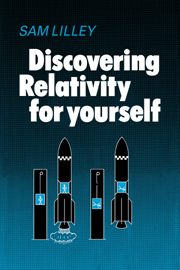Book contents
- Frontmatter
- Contents
- Preface
- Introduction
- 1 Getting started
- 2 Rough and ready Relativity
- 3 The dilation of time
- 4 Three clocks and a pair of twins
- 5 Starting again
- 6 Space–time diagrams
- 7 Time and distance ‘over there’
- 8 Co-ordinate systems
- 9 Combining speeds
- 10 Causality and the speed of light
- 11 The nature of spacetime
- 12 Interval
- 13 Old friends revisited
- 14 The scales of the spacetime diagram
- 15 The radar point of view
- 16 Relations between the radar and time–distance systems
- 17 Constant acceleration
- 18 Dynamics–mass, momentum, force
- 19 The mass–energy relation
- 20 The effect of acceleration on time measurement
- 21 Time as experienced by a constant acceleration traveller
- 22 Time and distance measurements of a constant acceleration observer
- 23 The Principle of Equivalence
- 24 The metric
- 25 Introducing geodesies
- 26 How to find ordinary geodesies
- 27 Inverse square law gravity
- 28 Curved spacetime
- 29 The metric around the Sun
- 30 Light and gravity
- 31 The scandal about Mercury
- 32 How Einstein did it
- 33 A few conclusions
- Index
- Frontmatter
- Contents
- Preface
- Introduction
- 1 Getting started
- 2 Rough and ready Relativity
- 3 The dilation of time
- 4 Three clocks and a pair of twins
- 5 Starting again
- 6 Space–time diagrams
- 7 Time and distance ‘over there’
- 8 Co-ordinate systems
- 9 Combining speeds
- 10 Causality and the speed of light
- 11 The nature of spacetime
- 12 Interval
- 13 Old friends revisited
- 14 The scales of the spacetime diagram
- 15 The radar point of view
- 16 Relations between the radar and time–distance systems
- 17 Constant acceleration
- 18 Dynamics–mass, momentum, force
- 19 The mass–energy relation
- 20 The effect of acceleration on time measurement
- 21 Time as experienced by a constant acceleration traveller
- 22 Time and distance measurements of a constant acceleration observer
- 23 The Principle of Equivalence
- 24 The metric
- 25 Introducing geodesies
- 26 How to find ordinary geodesies
- 27 Inverse square law gravity
- 28 Curved spacetime
- 29 The metric around the Sun
- 30 Light and gravity
- 31 The scandal about Mercury
- 32 How Einstein did it
- 33 A few conclusions
- Index
Summary
When you're in a train, you can't say whether it is really moving or not–that's an everyday experience from which our theory begins.
You can, of course, see the telephone poles flashing by. The naive interpretation of what you see would be that the poles are moving and you are not. Actually, all you can justifiably assert is the relative motion of the poles and yourself. And for further confirmation, think about all those films showing the inside of a railway compartment travelling at high speed – think about how the illusion of motion is actually produced (Remember: bold type means work for you–page 5).
From this sort of experience we've learnt that watching objects around us merely gives information about relative motion. It can never tell us whether they are moving or we are (or both).
Well then, would some test done inside the train tell us whether it is moving or not? For the present let's stick to trains in steady motion-at constant speed on a straight bit of track. I suggest that everything in this moving train happens in exactly the same way as if it were stationary. For example, the steady motion of the train doesn't make any difference to the problem of keeping your balance. You stand upright just as you would in a stationary train. What happens if you drop something?
It falls straight down as you see it, and lands right beside your feetjust as it would do if the train were motionless.
- Type
- Chapter
- Information
- Discovering Relativity for Yourself , pp. 9 - 19Publisher: Cambridge University PressPrint publication year: 1981



